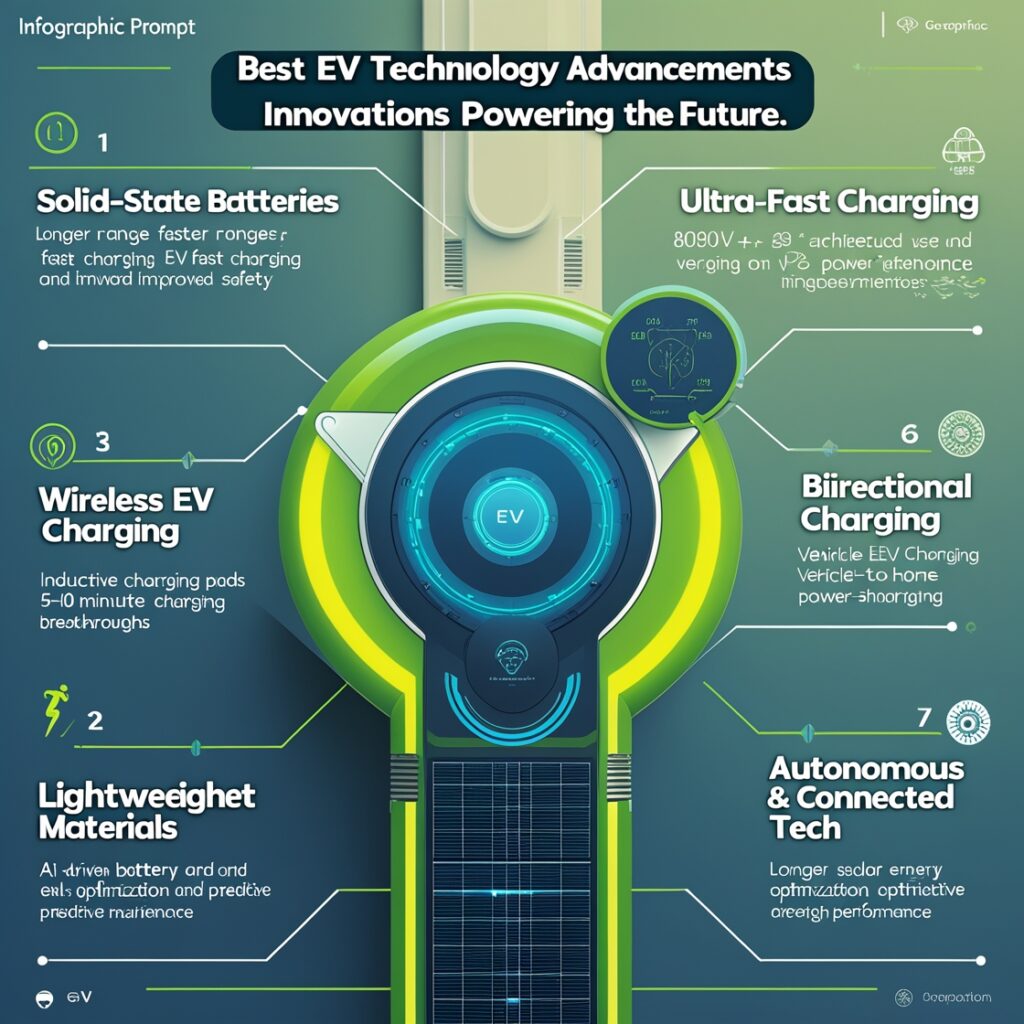If you’re not paying attention to electric vehicles (EVs), you’re missing the most electrifying revolution in automotive history. From best EV technology to AI-powered driving systems, the world of EVs is evolving faster than ever. The question isn’t whether EVs will dominate the roads—it’s how soon.

Let’s explore the best EV technology advancements shaping the future of mobility, one innovation at a time.
1. Next-Generation Battery Technology: Beyond the Limit
Battery innovation makes up the very backbone of EV progress. Well, say goodbye to range anxiety with game-changing advancements such as:
Solid-State Batteries: Companies like Toyota and QuantumScape are in the process of developing solid-state batteries that could boast higher energy density, quicker charging times, and longer life spans compared to their lithium-ion counterparts.
Lithium-Sulfur Batteries: These have an energy density five times that of lithium-ion and promise to revolutionize EV efficiency.
Sodium-Ion Batteries – A more affordable option for Li-based propulsion systems, demoting the urgent need currently set forth by the use of rare minerals.
2. Ultra-Fast Charging: Goodbye, Long Wait
Time is money; nobody wants to stay in a queue until your car gets fully charged. New developments in charging infrastructure are addressing this pain point:
800V Charging Systems – Porsche and Hyundai have introduced ultra-fast charging capabilities that can recharge 80% of a battery within less than 20 minutes.
Wireless Charging: Just drive up, and your car gets charged without your having to plug in. This is no longer science fiction. Companies like WiTricity are making wireless EV charging a reality.
Solar-Powered Charging Stations: Integration of solar energy with fast chargers is creating a sustainable charging ecosystem.
3. Autonomous Driving and AI Integration
The best EV technology advancements aren’t just about batteries. Here’s how Artificial Intelligence is transforming the way we drive:
Full-motion driver assistance through AI is increasing its pace closer to full independence with Tesla FSD.
LiDAR and Computer Vision – Waymo, Rivian have made LiDAR-based systems and are evolving further to assure more safety for road traffic.
Vehicle to Everything (V2X) Communication – All EVs communicate to each other and with Infrastructure around them – avoiding accidents on roads and planning better traffic movements.
4. Lightweight and Sustainable Materials
Gross weight down = efficiency improved. That said, automakers now head in the direction:
Carbon Fiber Composites: Used in high-performance EVs like the Rimac Nevera, it reduces weight while maintaining strength.
Recycled and Plant-Based Interiors: Brands such as Polestar and Tesla are furthering sustainable interiors with vegan leather and recycled plastics.
Aerodynamic Innovations: Improved aerodynamics, such as Tesla’s Cybertruck exoskeleton, promote range without adding bulk.
5. Bi-Directional Charging and Energy Integration
EVs are no longer just vehicles; they’re growing as energy hubs.
Vehicle-to-Grid (V2G) Technology: Vehicles such as the Nissan Leaf can return energy back to the grid, thus leveling out the peaks in energy usage.
Vehicle-to-Home (V2H) Systems: Best EV technology advancements will possibly power your home during an outage, acting similarly to a UPS for your energy needs.
Smart Charging Management: AI-powered solutions optimize charging loads according to demands, which greatly reduces electricity consumption costs.
6. Improved Performance and Efficiency
Speed demons and efficiency freaks, rejoice! EVs are now outperforming traditional gas-powered cars in many key areas:
Torque Delivery and Instant Acceleration – EVs like the Tesla Model S Plaid can hit 0-60 mph in under two seconds.
Regenerative Braking Systems – Capturing energy from braking to extend range is now standard across modern EVs.
Adaptive Thermal Management – Optimized cooling systems prevent overheating and improve battery longevity.
7. Expanding EV Infrastructure
Great cars are only one part of the robust EV ecosystem that is taking shape. Key developments include:
Supercharger Networks: Tesla’s global network of Superchargers sets the gold standard for fast, reliable charging.
Government Incentives and Subsidies: Countries all over the world are investing billions to promote the adoption of EVs.
Battery Recycling Programs: Companies like Redwood Materials are closing the loop on battery waste, ensuring the sustainability of the technology.
What’s Next: The Future of EV Technology
The best EV technology advancements are only the beginning. Look for even further developments in solid-state batteries, AI-driven personalization, even self-repairing materials. The EV industry isn’t about how we travel but about how we will change because of the relationship with energy and mobility.
If you still remain skeptical about EVs, one thing is sure: The future isn’t coming-it’s already here.